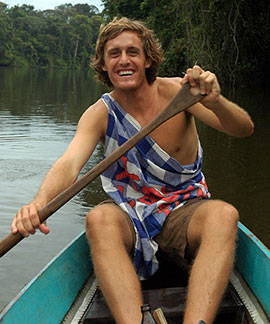This is an excerpt from an article by John Williams ’10 about his 2 1/2 years as a Peace Corps volunteer in Suriname. It appears in the autumn Colgate Scene.
Surrounded by impenetrable walls of tropical rainforest, perched in the stern of my dug-out canoe, I paddle leisurely downriver one early morning. Ligorio, a remote Saramaccan village in Suriname’s interior, peeks through the trees at the next bend in the river. As I approach the wooden staircase where I tie off my canoe, I come upon three heavy, half-naked women. They are bent over at the waist, scrubbing the traces of open fires from their pots to the rhythmic chatter of village gossip. As they subtly cover their exposed breasts by pulling up their pangis (sarongs), I become aware of my presence. I am foreign in a native culture, strange to all things familiar. And yet, I feel welcome.
 “Johnnie, I weki no?” the three women shelve their discourse and sing in unison. (Did you wake?)
“Johnnie, I weki no?” the three women shelve their discourse and sing in unison. (Did you wake?)
“Mi weki oooo,” I reply tunefully. (I woke.)
Every morning, Saramaccans roll out of their hammocks and greet each person with whom they cross paths — adult or child, neighbor or stranger — with these words. Their bellowing voices echo throughout the village and across the chestnut-brown river, but not much farther. A forgotten people in a relatively unknown country, their story remains muffled by the dense, untouched rainforest that covers 80 percent of the small former Dutch colony on South America’s wild northern coast.
I wrote myself into their story by committing two years of my life to international grassroots development as a Peace Corps volunteer beginning in May 2011. I landed in Ligorio, a demanding two-day journey from Paramaribo by car, motorized dugout canoe, and foot, that July. With electricity only from 7 to 11 p.m. and no running water, my home was a wooden shack on the grounds of a primary school, nestled between the jungle, the Gaan Lio (Big River), and a traditional area of worship.
I learned to speak Saramaccan and how to build a dugout canoe, ate foods of which I will never know the names, worked with machetes, fished for piranha, and played soccer. Meanwhile, I tried my best to serve the people, working with community leaders and local organizations to promote business, health, and youth development projects.
While it took me longer to understand and adjust to some aspects of Saramaccan culture and customs, I immediately took to gliding around the village greeting every person in sight, for I am a disciple of the Colgate Hello. But by living in Ligorio, I came to appreciate even more deeply the magnitude of that small, easy human gesture. . . .
(Please go here to read more.)